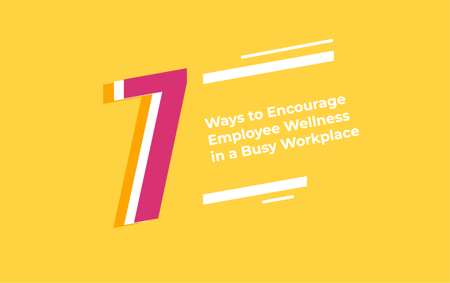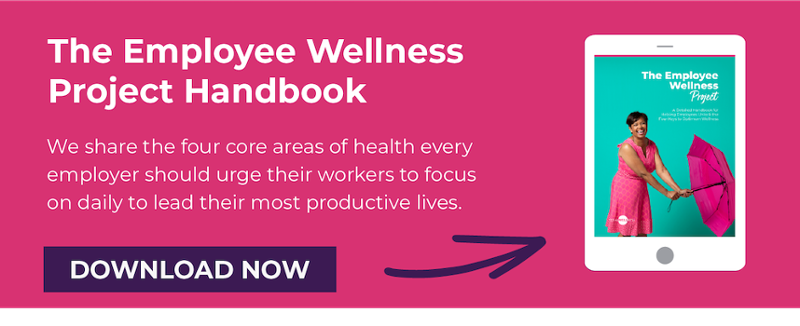 When employees are well, companies do well.
When employees are well, companies do well.
And considering that worker injuries and illnesses cost U.S. employers $225.8 billion each year — that’s about $1,685 per employee — keeping your workforce healthy is critical to a healthy business.
Luckily, there’s a way to stop that.
As a company, encouraging employee wellness through a variety of workplace initiatives can help employees feel and actually be healthier overall. Promoting lifestyle changes that are sustainable and feel doable is the key.
Employee wellness programs can include:
- Workshops
- Activities
- Health benefits
- Free printable resources
Knowledge is power, too. The more information you give your employees in an easy-to-digest format, the more likely they’ll retain it and use it. The first start, though, is encouraging them in the workplace to make healthier habits that they’ll hopefully bring home.
Here we share seven easy ways to promote employee wellness in your workplace:
1. Encourage Healthy Eating Habits
It’s important for employees to know that they can break away from their desk for a full lunch break. Scarfing food down while trying to multitask isn’t exactly an enjoyable way to take a lunch hour. It minimizes the ability to fully appreciate a meal, which can lead to overeating and mindless eating.
Promote healthy eating habits by:
- Offering fruit and veggies as break room snacks
- Allowing employees to take their full lunch breaks
- Buying healthy meals for lunch hour meetings
- Having an on-site fridge to encourage brown bag lunches
- Providing a juicer or blender for the office kitchen
Why It Matters: When employees start slowing down and eating healthier, their energy will spike and their moods will improve. Studies show what we eat does in fact impact our productivity. So help your employees fuel their bodies right in a calm, comfortable manner.
2. Promote Stress Management Strategies
Stress is that evil word that can get between an employee and their best work. Even your top employees are likely struggling with some sort of stress in their lives. Offering ways for employees to manage it can be helpful in boosting their self esteem, productivity levels, and overall well-being.
Encourage healthy stress management by:
- Taking the team on a retreat
- Buying stress management books for your workers
- Having a meditation room on-site
- Setting out adult coloring books for downtime
- Hosting a stress management lunch and learn
- Letting employees go home early
Why It Matters: Too much stress can destroy mental health and create a myriad of health problems. Don’t let stress overwhelm your employees to the point of a mental or physical breakdown. It will increase missed work days due to doctors’ visits or hospitalizations and perhaps even overwhelm an employee to the point of not returning.
3. Make Exercise Exciting
Sometimes it can be hard to get excited about exercise. It’s one of those personal wellness goals that often falls to the wayside for busy professionals. Yet fit employees can handle stress more effectively and will feel more energized to tackle deadlines and work projects.
Make exercise an office priority by:
- Posting lunch hour sign-up sheets for group workouts
- Creating walking or running groups
- Encouraging a group 5k walk/run
- Installing an office gym
- Practicing a daily yoga stretch as a team
- Hosting random events like hula hoop contests
Why It Matters: Want lower healthcare premiums? When your workers exercise, it improves their mental health and can decrease the risk of chronic diseases like diabetes or obesity. That means less doctors’ visits for them and lower healthcare costs for you.
4. Discuss Sleep Habits
This is one bedroom habit that should be discussed freely and often in the workplace. According to Sleep.org, sleep deprivation in particular costs U.S. companies about $63.2 billion a year in lost productivity.
How to encourage good sleep:
- Don’t let employees take weekend work home
- Conduct a sleep challenge to see how well employees sleep
- Bring in a sleep expert for a lunch and learn event
- Ask employees to shut down work email after 6 p.m.
Why It Matters: Quality sleep is a must for employees to maintain their physical and mental health. Being well-rested means your employees can make better decisions, think more clearly, and avoid burnout due to exhaustion.
5. Minimize Mental Health Stigma
Sadly, 8 out of 10 workers with a mental health condition reported that feeling shame about their mental health kept them from seeking help. When your company creates a workplace that values and promotes mental health services, it can encourage employees to get the help they need.
How to provide mental health support:
- Update and distribute mental health resources
- Host a psychologist for a mental health workshop
- Talk about mental health openly in the workplace
- Promote mental health content on social media
- Become a StigmaFree Company
Why It Matters: Mental health conditions like anxiety and depression aren’t health conditions that normally go away on their own. By encouraging employees to ask about their mental health benefits, they can get help sooner.
6. Allow Collaboration
As social beings, it’s important for humans to be together often. Studies show that being face-to-face with other people can help improve our resilience and reaction to stress. It also gives us a bit of a “high” and can numb pain thanks to the dopamine levels released during personal interactions.
Make collaboration a priority by:
- Encouraging employees to meet in-person
- Hosting (necessary) weekly meetings
- Granting flexibility in group meeting locations
- Including remote workers on conference calls
Why It Matters: In an era where technology has minimized the need for humans to ever talk at all, it’s important to remember that employees are still social beings. Teamwork can encourage other healthy habits like daily lunch walks and increased creativity in work sessions. Connecting with others is also a boost to mental health.
7. Create a Smoke-Free Workplace
Smoke-free workplaces creates a healthier environment for everyone. Plus, if an employee isn’t able to smoke while at work — where they likely spend a majority of their day — they may be able to quit the habit faster.
Promote a smoke-free workplace by:
- Sharing the impact of direct healthcare costs
- Creating a solid policy
- Designating a policy implementation period
- Offering smoke cessation programs
- Participating in the Great American Smokeout
Why It Matters: By creating a smoke-free workplace, it not only helps smokers cut back or nix an unhealthy habit, it creates a safer environment for everyone who comes into the business. It’s an employee wellness win for all when smoke-free policies are put in place.
Employee Wellness Means Personal Wellness
When your company encourages employee wellness programs, it increases the chances of workers caring about their personal wellness.
Some employees may not know where to go for the best resources to help them achieve optimum health. As an employer, keeping workers updated on all of their healthcare benefits and company resources can make all the difference.
Whether your company offers free health resources, hosts regular wellness workshops, or gives health perks like gym memberships, it all comes down to doing whatever works to encourage employee wellness.
Ready to help your employees take on their own personal health campaign? Download our newest free handbook: The Employee Wellness Project!



